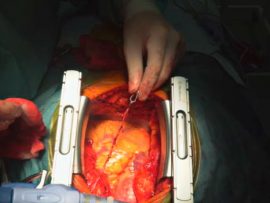Abstract Objective There are few data on the role of in patients with end-stage heart failure supported by mechanical . The aim of our study was to investigate predictors for in patients with..
Read MoreAbstract Background Data are sparse on long-term mortality after coronary artery bypass graft (CABG) surgery. We examined short-term and long-term mortality of patients undergoing CABG surgery and a general population..
Read MoreAbstract Quality problem or issue The traditional variable life-adjusted display (VLAD) is a graphical display of the difference between expected and actual cumulative deaths. The VLAD assumes binary outcomes: death..
Read MoreAbstract At the time of writing this editorial, I have been in health care for exactly 45 years. These years have taken me through many challenging settings, including intensive cares,..
Read MoreAbstract Static cold storage is accompanied with a partial safe ischemic interval for donor hearts. In this current study, a machine perfusion system was built to provide a better preservation..
Read MoreThis report describes the case of a 63-year-old female patient, who was admitted to the Intensive Care Unit with the diagnosis of septic shock. [pdf-embedder url="https://perfusfind.com/wp-content/uploads/2021/03/caso-semana-cyto_compressed.pdf" title="caso semana cyto_compressed"]
Read MoreAbstract OBJECTIVES The aim of this study was to assess the safety and effectiveness of our selective antegrade brain perfusion (SABP) strategy, which is characterized by moderate hypothermic and low-pressure..
Read MoreAbstract OBJECTIVES: Combined coronary artery bypass grafting and valve surgery requires a prolonged period of cardioplegic arrest (CA) predisposing to myocardial injury and postoperative cardiac-specific complications. The aim of this..
Read MoreGuidelines for the management of pre-operative paediatric clear fluid fasting historically recommend a minimum of 2 h. In particular, the published guideline from European Society of Anaesthesiology (ESA) in 2011,..
Read MoreThe purpose of this guideline is to present evidence-based and consensus-based recommendations for the prevention and treatment of postoperative delirium. The cornerstones of the guideline are the preoperative identification and..
Read MoreAbstract Introduction: Pulmonary endarterectomy (PEA) is the most effective treatment available for chronic thromboembolic pulmonary hypertension (CTEPH). Patient selection, surgical technique and perioperative management have improved patient outcomes, which are..
Read MoreAbstract Introduction: The use of cardiopulmonary bypass is associated with a risk of neurocognitive deficit caused by gaseous microemboli. Flushing the empty bypass circuit with carbon dioxide, which is more..
Read MoreAbstract Extracorporeal membrane oxygenation (ECMO) is a life support system that circulates the blood through an oxygenating system to temporarily (days to months) support heart or lung function during cardiopulmonary..
Read MoreAbstract Objective To evaluate the current practice of perioperative fluid management in cardiac surgery patients. Design Multiple choice survey with 26 questions about existing practice of perioperative fluid management in..
Read MoreAbstract Objective has been associated with both and in studies based on (TEG). Severe hemodilution during (CPB) is a risk factor for morbidity in cardiac surgery. This study investigated the effects of different degrees..
Read MoreAbstract We describe our experience of 30 consecutive children supported with ECMO and receiving 20 ppm of nitric oxide in the oxygenator of the ECMO circuit. Administration of nitric oxide..
Read MoreAbstract Objective (POD) is a common complication after cardiac surgery and is associated with increased patient morbidity and mortality. The objective of this study was to identify risk factors for..
Read MoreAbstract BACKGROUND: Blood transfusion is used to treat acute anemia with the goal of increasing blood oxygen-carrying capacity as determined by hematocrit (Hct) and oxygen delivery (DO2). However, increasing Hct..
Read MoreAbstract This article represents the first attempt to perform a pooled analysis about remote ischaemic preconditioning (RIPC) in reduction of acute kidney injury (AKI) of adult patients undergoing cardiac surgery..
Read MoreAbstract OBJECTIVES: The three direct oral anticoagulants (DOACs) dabigatran, apixaban and rivaroxaban are now widely used in clinical practice. For patients requiring perioperative interruption of DOACs, heparin bridging is still..
Read MoreAbstract Objective Little is known about the outcomes of operations that involve inducing hypothermic circulatory arrest for relatively extensive proximal . We attempted to identify predictors of postoperative hospital length of stay..
Read MoreAbstract Background Renal injury is a serious complication after cardiac surgery and therefore, early detection and much more prediction of postoperative kidney injury is desirable. Neutrophil gelatinase-associated lipocalin (NGAL) is..
Read MoreAbstract OBJECTIVES: This study investigated whether the novel St. Thomas’ Hospital polarizing cardioplegic solution (STH-POL) with esmolol/adenosine/magnesium offers improved myocardial protection by reducing demands for high-energy phosphates during cardiac arrest..
Read MoreAbstract BACKGROUND Four predictive models for acute kidney injury associated with cardiac surgery were developed by Demirjian in the United States in 2012. However, the usefulness of these models in..
Read MoreWe are writing to point out a simple clinical sign in a pedagogic way, about recirculation in venovenous extracorporeal membrane oxygenation (ECMO). These last years, ECMO has emerged as a..
Read MoreAbstract In this letter, the innate ability of nitric oxide (NO) to inhibit platelet activation/adhesion/thrombus formation is employed to improve the hemocompatibility and in vivo accuracy of an intravascular (IV) potentiometric PCO2 (partial pressure..
Read MoreAbstract Air embolism is an uncommon, but potentially life-threatening event for which prompt diagnosis and management can result in significantly improved patient outcomes. Most air emboli are iatrogenic. Arterial air..
Read MoreAbstract Reducing surgical trauma by minimizing skin incisions has transformed abdominal surgery resulting in significant improvements in outcome. In cardiac surgery, such efforts have also been made, but similar benefits..
Read MoreAbstract The objective of this study was to compare the hemodynamic performances and gaseous microemboli (GME) handling ability of two pediatric oxygenators in a simulated pediatric cardiopulmonary bypass (CPB) model..
Read More



















